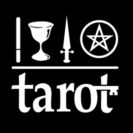Spider and tarot hold a deep secret. Tucked away around the edges, cobwebs appear on the Thoth Art Atu. There is nothing in Aleister Crowley’s commentary on spiders or cobwebs, but there is a comment in Liber 777 on Column XXXVIII:
The Spider is particularly sacred to Tiphereth. It is written that she “taketh hold with her hands and is in king’s palaces.” (The most characteristic title of Tiphereth is “Palace of the King.”) She has six legs and is in the centre of her web exactly as Tiphereth is in the centre of the Sephiroth of Ruach.
Now of course Spiders have eight legs and there are eight paths to Tipareth. On the Tree of Life, the Art card is on the vertical path from Yesod to Tiphereth, so it is as if we enter Tiphereth through a cobwebbed portal. Spiders have the ability to span distances through silken threads, and cobwebs of course span space. Another interesting point is that Tipareth is masculine, the Son/Sun, but Crowley refers to the Spider as ‘She’, so we may well infer that the she enables us to access different worlds Tipareth to Malkuth or Kether of Trees above and below.
To the Native Americans, Grandmother Spider is the weaver who brought the gift of fire from the other side of the world. Remarkably, many of the shamanic qualities of the Spider reflect the qualities of the Art card.
Spider Cults
Spider Cults are fascinating, as they were suppressed by Christianity. The symbolism on the Art card encapsulates alchemy and sex magic, but Aleister Crowley does not explicitly discuss these important themes.
Darcy Kuntz (The Golden Dawn Tarot by A.E. Waite) viewed that:
“Waite felt that the most appropriate name for the Tarot deck should be The Wheel of Fortune or The Great Wheel.”
Fortune, along with the Chariot is closely connected to the Chariot Vision in Ezekiel. Far from being two-dimensional, the Wheel has three dimensions, and the direction of spin changed
when certain “keys” appear the motion of the Wheel is reversed. Mr. Parisious suggested that Florence Farr and the Sphere Group started the spinning of the Fool’s eight pointed wheel in 1898. (See Kuntz’s The Enochian Experiments of the Golden Dawn, 1996). The Fool’s wheel is also contained in the centre of the Wheel of Fortune.’
Kuntz, The Golden Dawn Tarot by A.E. Waite
Spiders spin webs, they have eight legs, and here we have the suggestion of wheels within wheels.
Waite had no intention of revealing his true thoughts on the design of at least some of the Tarot cards:
I saw to it therefore that Pamela Coleman Smith should not be picking up casually any floating images from my own or another mind. She had to be spoon-fed carefully over the Priestess Card, over that which is called the Fool and over the Hanged Man
Shadows of Life and Thought, 1938
The Tree of Life and the Spider
Most people see the Tree of Life as having three paths connecting Malkuth at the bottom to the rest of the Tree, but this is not the only arrangement. Some early versions have a single path from Yesod to Malkuth, and if we include the symbol of the Spider, as the Golden Dawn did, we have only a slightly abstracted version of the Tree as a cobweb with suspended spider. Vogh identifies the Spider as lunar, and we know that the Lunar or Feminine aspects of divinity suppressed in Kabbalah.
Astronomy
In Volume 9 of the Golden Dawn book, the Tarot relates to the Celestial Heavens. Here are the cards associated with the Spider’s area of the sky. King of Swords – 20° Taurus to 20° Gemini Head and body of Castor (Gemini), part of Auriga (Cancer), and Capella, head and forepart of Lynx, forefeet of Camelopardis The Heirophant – Taurus Head and forepart of Taurus the Bull. Part of Orion. The beginning of the River Eridanus Art – Sagittarius
The Art Atu
Art or Temperance relates to Sagittarius, the opposing sign to Gemini or the Lovers. Aleister Crowley makes clear that the two cards are intimately related to each other, and studied together.
The Heirophant
Orion is also known as Horus who is of course tremendously important in the Golden Dawn and Thelemic systems. Horus, the Crowned and Conquering Child, depicted on the Hierophant card in the midst of the Priestly figure, within a Pentagram.
